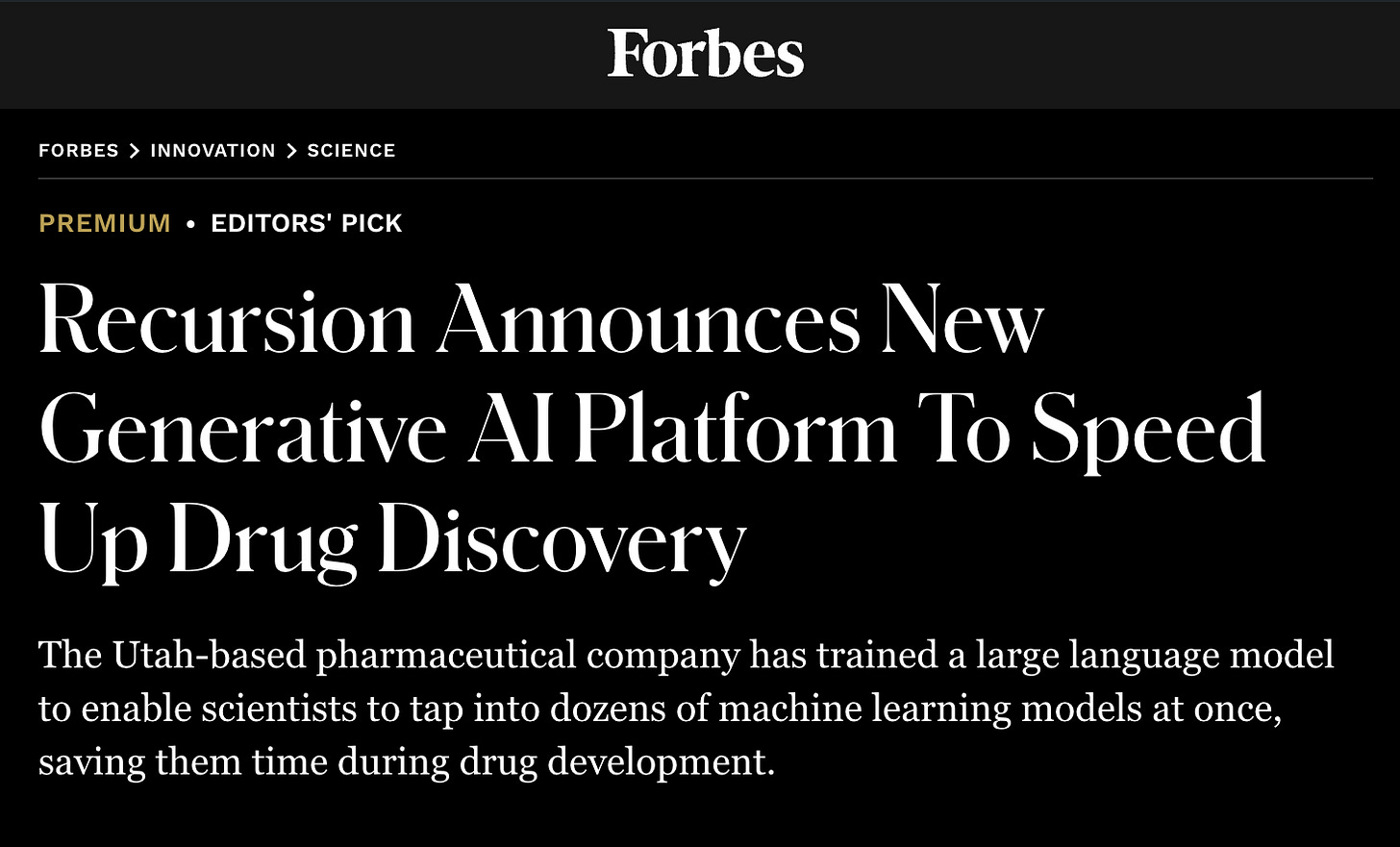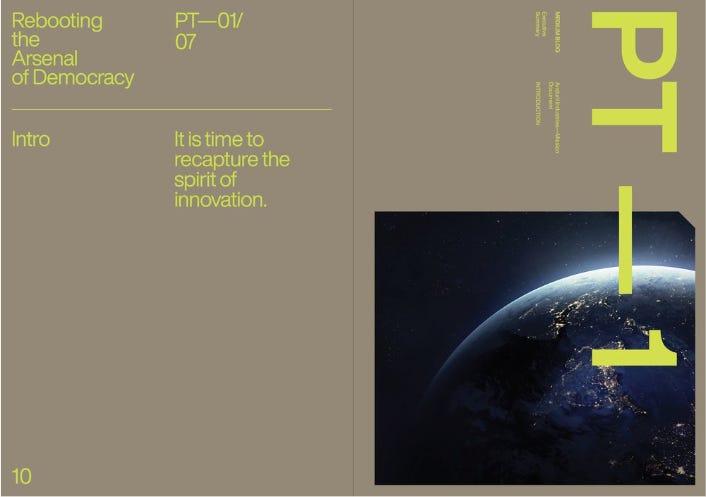Good technology doesn’t speak for itself
Why storytelling matters from inception to IPO and beyond
Introduction
My company’s valuation lags that of my competitors.
Investors aren’t flooding my inbox to lead a big round.
I’m struggling to hire A players.
I’m losing out in procurement processes.
Regulators seem to treat me worse than my peers.
My technology isn’t getting the recognition it deserves…
These are all things we’ve heard start-ups lament. In every case, there was nothing fundamentally wrong with the product, the quality of the team, the market, or the “why now?”. The problem was a universal failure in storytelling.
At Air Street, we believe strong storytelling is essential to stronger company building. Whether creating a new category, battling incumbents, or facing regulatory uncertainty, hoping that technology will speak for itself just isn’t good enough.
In that spirit, we’re addressing a few common myths, sharing some examples of compelling storytelling, and flagging some pitfalls to avoid.
What storytelling is and what it isn’t
Storytelling means explaining what you’re doing, why you are doing it, and why anyone should care. You must do this clearly to the audiences that need to understand it most.
Many, but not all, technologists feel an instinctive aversion to all things narrative. It’s often wrongly conflated with two different things:
Firstly, hype. They will have seen other founders raising money while making outlandish claims and assume that you’re encouraging them to do the same. However, hype has a shelf-life. Capital markets will - at some point - conclude that your office rentals business is not going to bring about world peace. If you can’t explain why your business is doing something important without lying, communications are not your biggest challenge.
Secondly, ‘dumbing down’. This is based on the academic notion that complexity equates to purity. When you introduce yourself in a meeting, you might say your name and what you’re working on. You probably don’t give an account of every year of your life. In this scenario, you are not ‘dumbing down your life story’, you are communicating the information that is relevant for your audience at an appropriate length.
Good storytelling is critical, especially if you are working on something complex. Many of the reasons are obvious:
If no one understands the problem you’re working on, your solution will be of little interest.
It’s unlikely anyone else will either write about it or spread it via word-of-mouth.
Lack of validation means potential partners, customers, employees, or investors will doubt your legitimacy.
External communications is also a valuable sense check for senior leadership. It’s a powerful antidote to groupthink and decision-making by committee. If a company cannot clearly explain a decision or a policy change to someone who wasn’t in the room when it was made, it’s a reliable red light on the dashboard.
Recursion Pharmaceuticals: bringing a new category to life
Traditionally, businesses working in biopharma have communicated conservatively. With well-established names, a fastidious regulator in the FDA, and a relatively stable base of institutional investors, outside periodic dust-ups with activists, there’s little incentive for them to be ‘innovative’.
As a result, they often default to the classic mistake of publicly-traded companies - turning communications into a de facto arm of legal. This means storytelling is primarily conducted via dry, jargon-packed newswire releases, shot-through with caveats. These are then dutifully picked up by the same group of pharma trade outlets.
This is adequate if you’re an incumbent with a healthy drug pipeline, exclusivity on blockbuster medicine cash flowing in, and a market capitalization of $200B. But if you’re pursuing a fundamentally different approach, like our friends at Recursion, being adequate is a non-starter.
Recursion, which started in phenomics - the use of AI to analyze microscopy images of cells treated with perturbations - is combining one of the largest in-house generation platforms for biological and chemical datasets in the world with AI and large-scale computing to create maps of health and disease with which to discover new medicines. This systematic data-driven approach enables Recursion to conduct millions of wet lab experiments weekly and is powered by the biopharma industry’s largest GPU cluster.
However, the company has a challenging task, which involves:
Developing the TechBio playbook and educating public markets and the industry in real-time;
Winning over top AI talent;
Winning over partners in traditional pharma, many of whom have witnessed past false dawns in AI for drug discovery;
Convincing rising startups with accretive technology or biology that they’d scale faster by joining forces with Recursion.
The traditional biopharma comms playbook is simply unable to do this.
Instead Recursion has nailed their narrative without embracing marketing gimmicks or diluting their seriousness. Bluntly, they’ve just put significantly more effort into storytelling than many of their peers.
This means, for example, going beyond traditional biopharma media for product announcements:
And going where the talent is, not waiting for it to come to you:
It helps that Chris (CEO) is personally a very compelling story-teller and a natural evangelist for the company and TechBio industry at large.
But this philosophy runs through the company’s other efforts, including high-production quality videos and blog posts that don’t require a PhD in computational biology to parse. The company’s social media channels are updated significantly more regularly (with a heavy quantity of third party content) and display more personality. Again, Chris leads from the front:
These points are important. It’s easy for companies to develop media coverage tunnel vision. Instead of taking a longer-term view and developing high-quality content, they fixate on chasing after the empty calories of the quick media hit. Good owned content is often significantly more valuable than press release write-ups in minor outlets that no one reads.
Not only does it serve as a reference point, the act of producing it regularly, seeing what drives engagement, and receiving feedback helps you to optimize your focus and tone. Going direct shouldn't be seen as the back-up option or a sign a media pitch hasn’t resonated - often it is the best approach.
Anduril: realizing who matters, and who really doesn’t
If you’re doing something important, not everyone is going to like it. Activists, incumbents, or peers who disagree with your approach will try to shut you down. But this shouldn’t produce paranoia. I’ve lost count of the number of companies I’ve advised that either buried announcements or scaled them back, out of fear of one snarky quote.
Businesses have more license than they realize. Anduril faced intense hostility head-on when they launched. Palmer Luckey was roundly pilloried by media outlets as at best eccentric, or at worst, dangerous.
Remember, this was the era when Big Tech was looking both ways on national security. On the one hand, Google publicly pulled out of its Project Maven contract with the Pentagon following employee protests. On the other hand, senior execs worked to reassure the government that it was committed to supporting the military.
The ‘safe’ move would have been to shy away from controversial border work, sign a ‘responsible AI’ pledge, and hire an ethics board of luminaries from government and academia.
Instead, Anduril had two crucial insights.
Firstly, that they didn’t need everyone to like them. Some people and organizations are unwinnable. Instead, they focused on communicating directly with people who were either predisposed to be supportive or were still on the fence.
Their Rebooting the Arsenal essay remains one of our favorite pieces of corporate storytelling. It walks through the need for US resilience, the failures of the defense-industrial complex, and Anduril’s solution. There’s no exaggeration, alarmism, or dumbing down. It sets out the challenge before providing the solution. It doesn’t assume knowledge, while respecting the reader’s intelligence.
Lulu Cheng Mersevey, who advised Anduril on communications, set out their playbook in greater depth, and how it eventually saw the media start to give them a fairer hearing.
Secondly, the company’s product marketing exudes purpose. You see this both in product demonstrations that make you not want to be an enemy of the United States and the way they foreground their team. Fans even remix their content to promote the brand.
The production values are more akin to a luxury consumer brand than a company that serves the government. But Anduril understands that if you’re an outsider breaking into a rigged market, the rules are different.
It’s not enough just to out-innovate your competitor. You need the customer to want your product so badly that they’ll bring walls of bureaucracy tumbling down just to get their hands on it.
Learning the wrong lessons
In the past year, there has been a shift in how some companies and prominent figures in the tech world approach these questions. Driven by a combination of a social media echo chamber and perceived unfairness in some media coverage, there has been an embrace of a much punchier style of communication.
This is often grounded in slightly lazy extrapolation from the Anduril playbook. Anduril’s approach worked well, because:
A degree of aggression was necessary when defense technology sector faced existential questions in its early days;
Companies working in the space genuinely couldn’t get a fair hearing in the media (or as Palmer pointed out, even from certain ‘contrarian’ podcasters)
It was sincerely felt and authentic to the founder;
The ‘hard core’ aesthetic in other areas of the company’s communications was natural given the company was producing hardware for defense.
This will not always hold true for others. When we work with companies in the Air Street portfolio on refreshing their external image, we obviously look at others we admire (including Anduril). But we also have to imagine the co-founders standing in front of a potential customer and trying to embody that image.
A hard rock soundtrack, videos of things exploding, and trenchant criticism of incumbents works for some. But if the founders are mild-mannered and trying to disrupt a conservative industry, they will likely fail to live up to the pitch and said pitch will probably annoy their customers. If you’re working on B2B SaaS, the aesthetics of El Segundo tip over into cringe. And not in a ‘so bad it’s good’ way.
Times change
Tonally, what works for a company that has already raised billions of dollars and gained traction often does not work for companies at pre-seed or seed. The same is true for first-time founders versus teams with a clearer track record. To some extent, you have to earn the right to be ‘out there’ - there is a fine line to tread between ambition and absurdity. As we said in our post on non-consensus ideas, being insane or whacky for the sake of it is usually unwise.
In a company’s early days, it’s important to convey ambition alongside real-world adjacency. If you take a company like Stripe, it has routinely referred to how it “builds economic infrastructure for the internet” for a number of years.
However, its early positioning was much more grounded.
As a new company in a newish sector, they had to convince potential customers that their platform was secure and reliable, while navigating a complex landscape of financial regulations. Trust was much more important than either changing the world or appearing as hardcore as possible. References towards building infrastructure for the internet didn’t become a mainstay of Stripe’s communications until 2017. By that stage, the company was known, trusted, and had already raised several hundred million dollars.
Even Anduril’s own approach to these questions has not been static. Now defense technology is widely accepted as a necessity and the company has started winning significant contracts, it doesn’t need to justify its existence. It spends much less energy positioning itself as a scrappy underdog. It has released a new long-form essay that focuses less on the case for defense tech and more on the need to bolster US manufacturing capacity to enable affordable mass for autonomous systems, weapons, and munitions. This also ties in with the company unveiling plans for its Arsenal-1 factory, a planned facility to streamline the manufacturing of Anduril products at scale.
…and what happens if you ignore all this?
In most cases, if you ignore the importance of storytelling, you’ll experience a steady failure to live up to expectations and slide into irrelevance. At the most extreme end, however, we can see a lack of basic alignment on what the company actually does.
If a company’s identity is grounded in aggressive, but ultimately quite vague, ambitions, then it becomes surprisingly easy to avoid answering tough questions early on. These get brushed under the carpet by a swathe of quadrants or market maps with ‘white space’, along with broad agreement that others are doing badly.
For example, Paris-based H Company appears to be on the brink of disintegrating, just months after raising a $220M seed round. Three of the five co-founders have now quit on the basis of “operational differences”.
While we don’t have any secret insight into what happened nor are we here to pass excessive judgment on entrepreneurs taking risk, as outsiders, we saw i) a company thrown together very quickly ii) a pitch largely grounded in the founders’ past Google DeepMind affiliation, and iii) an absence of any clear plan outside of training models for agentic workflows with state of the art methods and architectures.
The company engaged the following exercise in positioning - dubbing their competition myopic and committing to two abstract nouns and an adjective:
While SOTA models for agents is a potentially promising commercial direction, it is not by itself a cohesive pitch - it could be practically taken in a hundred different directions. When you position yourself like this, it’s easy to conceal any number of disagreements. Individual members of the founding team can project their preferred approach onto what was agreed.
While a focus on storytelling would not have fixed these problems necessarily, a more disciplined approach may have flagged up the founding teams’ now apparent lack of alignment on a series of important questions. As a result, they may have concluded that they shouldn’t go into business with each other, before raising close to quarter of a billion dollars of external investment.
Closing thoughts
Along with effort, courage, and the ability to adapt, there’s another crucial ingredient. In both success stories of Recursion and Anduril, the founder or founding team needs to be bought into the importance of storytelling. They didn’t delegate it and they made the effort to lead from the front. Paying external consultants is not an adequate substitute. It results in an unused but expensive piles of documents and slides.
Alongside help with hiring, marketing, and product, we work closely with founders on storytelling. This covers everything from narrative development through to media engagement, and often involves pen to paper before we’ve finalized an investment.
We’ll leave the last words to Lulu’s Anduril playbook: “Mission-driven startups need founder-led comms. Only a founder can be the chief evangelist for their company. By assuming that responsibility and using that power, you can change narratives, change minds, and change the course of history.”











